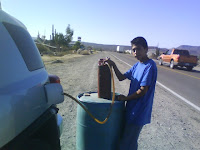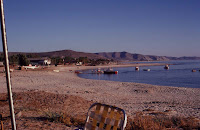
Something I forgot to mention is that there are military stops scattered here and there. If you are traveling south, they rarely stop cars with US plates. I guess they figure we're not smuggling pot INTO Mexico. If they stop you, they will ask where you are travelling from. Then where are you going. That's about it. I've always been treated with courtesy at these stops. Remember: by and large they are simply doing their job.
When you return North, they are more concerned with US plated vehicles. You might get searched for guns and drugs. Generally speaking these soldiers are lightly trained young men who are living in very basic conditions with very little entertainment outside of searching cars. It's always a good idea to carry something to give the kids. Believe me when I tell you, they will appreciate it. I handed out bottles of water one trip and Reece's peanut butter cups another time. One trip North I had a backpack in the back of a trailer and inside, I had somehow left a cleaning kit for a .22 caliber rifle. At the last stop before Tijuana, a young soldier found it. He asked me what it was. I told him and asked if he had a .22 rifle. He said yes so I gave him the kit. I've never seen a half-dozen soldiers lose interest in a car inspection so fast. The other boys were all huddled around the lucky one checking out his prize. The thing to remember is don't be afraid or worried. Normally they just ask a few questions and send you on your way.
Meanwhile, back at the journey,
+%5B640x480%5D.JPG)
I already told you about the long drive without gas between El Rosario and Guerrero Negro. If you get in a jam you can buy gas at Cataviña on the side of the road. This guy with the drums must really get a kick out of us dummies that can't do the math. Oh yeah, I said "us dummies." I've bought gas from him 2 or 3 times.
There is a section of road in the mountains I think between Cataviña and Gurrero Negro that has new pavement. They have not replaced all the signs yet. You'll recognize it because of the lack of curve signs. There are 2 curves that are nasty. I went into one at night doing 50 or so and nearly didn't come out the other side. So if you can't see how sharp the curve is, fear for your life.
You will drive past a gas station (or into it maybe) then through a military base just North of Guerrero Negro and soon after is an agriculture stop. They'll take any fruits or veggies from you and ask for 10 pesos "cooperacion" (like a donation) and then you drive across a pipe that sprays something, presumably bug killer, up under your car. As soon as you clear the sprayer thing, pull over and get your tourist visa stamped at the little trailer.
Next is Guerrero Negro but there's not much there if you're not going whale watching or need gas or a hotel. It's always like an Oregon coastal town: overcast, windy and cold. They have salt production and whales, not much more.

It's about 130 miles to Santa Rosalia from Guerrero Negro. There's gas at Vizcaino and San Ignacio. The first few miles out of G.N. is kind of blah then there's a yucca forest with huge yuccas. It's really green now because of the storm that just blew through.

Then you pass San Ignacio, then arrive at Santa Rosalia. If you are going to get gas, buy it at one of the first 3 or so stations. The last one in town is a notorious ripoff. Bajanians with more than a few trips under their belts all have stories about the various tricks they use to rob or short-change you there. Santa Roselia still has quite a bit of un-repaired hurricane damage but all services are restored and traffic-wise, everything is normal.

There's some great photo ops along the coast as you travel south past Mulege and Loreto and on through the mountains. Stop when you see something good. You have time: don't get in the "we have to get there" mode. Promise?
Next: Arriving home.





